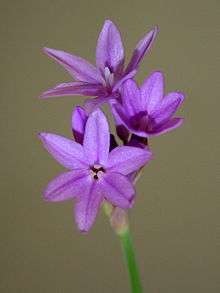Tulbaghia violacea
Tulbaghia violacea, also known as society garlic, is a species of flowering plant in the family Amaryllidaceae, indigenous to southern Africa (KwaZulu-Natal and Cape Province), and reportedly naturalized in Tanzania and Mexico.[1]
| Tulbaghia violacea | |
|---|---|
.jpg) | |
| Scientific classification | |
| Kingdom: | Plantae |
| Clade: | Tracheophytes |
| Clade: | Angiosperms |
| Clade: | Monocots |
| Order: | Asparagales |
| Family: | Amaryllidaceae |
| Subfamily: | Allioideae |
| Genus: | Tulbaghia |
| Species: | T. violacea |
| Binomial name | |
| Tulbaghia violacea | |

Growing to 60 cm (24 in) tall by 25 cm (10 in) wide, it is a clump-forming perennial with narrow leaves and large clusters of fragrant, violet flowers from midsummer to autumn (fall).[2][3]
Cultivation
When grown as an ornamental, this plant requires some protection from winter frosts. This species[4] and the cultivars ‘Purple Eye’[5] and ‘Silver Lace’, with cream-margined leaves,[6] have all gained the Royal Horticultural Society’s Award of Garden Merit.[7]
Medicinal uses
Tulbaghia violacea is used locally as a herbal remedy/medicine to treat several ailments. Recently it was demonstrated to have androgenic[8] and anti-cancer[9] properties in vitro.
Tulbaghia violacea exhibited antithrombotic activities which were higher than those found in garlic.[10]
Odor
It may smell like marijuana or skunk to those familiar with either smell.[11] There have been instances in which concerned neighbors have contacted the authorities about the smell of cannabis in the neighborhood only to find out that the culprit was actually lemon verbena or society garlic.[12]
References
- Kew World Checklist of Selected Plant Families
- RHS A-Z encyclopedia of garden plants. United Kingdom: Dorling Kindersley. 2008. p. 1136. ISBN 1405332964.
- Harvey, William Henry 1837. Botanical Magazine 64: t. 3555.
- "RHS Plant Selector - Tulbaghia violacea". Retrieved 7 June 2013.
- "RHS Plantfinder - Tulbaghia 'Purple Eye'". Retrieved 29 December 2018.
- "RHS Plantfinder - Tulbaghia violacea 'Silver Lace'". Retrieved 27 December 2018.
- "AGM Plants - Ornamental" (PDF). Royal Horticultural Society. July 2017. p. 103. Retrieved 27 December 2018.
- Mozaffar Ebrahim & Edmund John Pool (2010). "The effect of Tulbaghia violacea extracts on testosterone secretion by testicular cell cultures". Journal of Ethnopharmacology. 132 (1): 359–361. doi:10.1016/j.jep.2010.08.018. PMID 20723589.
- S. Thamburan, F. February, M. Meyer, J. Rees & Q. Johnson (2009). "Tulbaghia alliacea: A potential anti-cancer phytotherapy". Planta Medica. 75 (9): SL35. doi:10.1055/s-0029-1234290.CS1 maint: multiple names: authors list (link)
- Lelethu Bungu, Maryna van de Venter & Carminita Frost (2008). "Evidence for an in vitro anticoagulant and antithrombotic activity in Tulbaghia violacea". African Journal of Biotechnology. 7 (6): 681–688. ISSN 1684-5315. OCLC 920391224.
- Feix, David (25 Feb 2002). "Re: Society Garlic". hort.net.
- Kuperstein, Adam (18 May 2010). "Mystery Smell in Weston". NBC Miami.
External links
| Wikimedia Commons has media related to Tulbaghia violacea. |